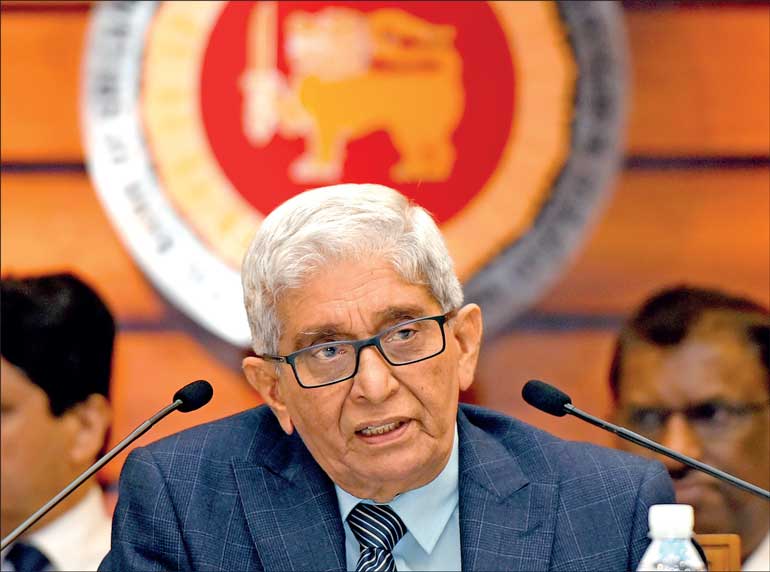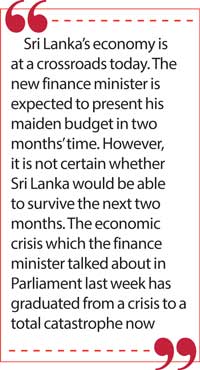Tuesday Apr 22, 2025
Tuesday Apr 22, 2025
Monday, 13 September 2021 00:10 - - {{hitsCtrl.values.hits}}

During his tenure, the Central Bank became a virtual printing press expanding the money stock by Rs. 2.8 trillion or 35% in the guise of following an alternative economic policy stance. At the last lap of his Governorship, he has now delivered a final shock to the forex market
Far-sighted Central Bank Governors in the past
I learned a fine lesson from Governor Warnasena Rasaputra about shock treatments in central bank policy in early 1980s. In the first three years of that decade, money stock was rising at a phenomenal rate of 26% annually, inflation was unbeaten at above 20%, global interest rates were on the increase, and above all, the money multiplier was ominously accelerating from 2.27 in 1977 to 3.35 in 1982.
inflation was unbeaten at above 20%, global interest rates were on the increase, and above all, the money multiplier was ominously accelerating from 2.27 in 1977 to 3.35 in 1982.
He told us from the Economic Research Department: “The chaotic situ in the market is so alarming that we have to shock treat the financial system. But remember, without a quick exit time, it will kill the patient. Your job is to come up with a market-based monetary policy plan to save the patient in the medium to long run.” Governor Rasaputra shock treated the financial system by introducing the most stringent quantitative policy controls, made a turnaround in the chaotic money market, and reverted to smooth transition to market-based monetary policy system.
That was a journey started by a far-sighted Central Bank Governor and continued by subsequent Governors, especially during the tenure of Governor A.S. Jayawardena. The Central Bank thus earned the reputation of being market-friendly and not anti-market. It enabled the Bank to work collaboratively with the financial institutions which were under its supervisory control. Such collaboration based on mutual trust is important because seeking collaboration in national interest does not work in a market.
The arbitrary fixing of the exchange rate
Now, Governor W.D. Lakshman has reversed it. In a letter addressed to CEOs of commercial banks and the National Savings Bank, which is in free circulation in the market today, he has asked the banks to keep their selling rate of the dollar within the agreed range of Rs. 200 to 203 per dollar. This amounts to introducing a maximum retail price or MRP to US dollar, like the MRP fixed on rice and sugar by the Government. The difference is that, in the case of sugar and rice, it is through a Gazette Notification issued under the authority of the Consumer Affairs Authority Law or CAAL.
But the MRP fixed on the dollar is not under any law or through a formal direction of the Central Bank. It is just a letter addressed to CEOs of banks, but its authority is much more powerful than those issued under CAAL. He has said that his request has the full backing of the Government and both the Central Bank, and the Government are working in concert on this matter. He has added: “Needless to say, the CBSL has necessary tools and intervention instruments, to be used to ensure that financial institutions duly comply in the greater national interest that is overwhelmingly paramount.”
Every commercial banker knows that Central Bank’s tools and instruments are more punitive than the punishments being meted out by courts of law. Fixing the exchange rate below the market rate is, however, not in the greater national interest as claimed by Governor Lakshman. It is profitable to buyers of foreign currency but injurious to its sellers. Hence, it serves only a part of the national interest: the buyers of dollars. In that category too, the Government which can now buy dollars at a cheaper rate to repay its foreign debt is placed prominently.
The Lakshman shock will breed a flourishing black market
The letter delivered a shock to banks. It was an unusual shock because, despite its objective of stabilising the market, it caused a major instability. Given the shortage of dollars in the market, banks had been buying and selling dollars above the prescribed range of the Central Bank. The range announced on the website of the Central Bank was Rs. 199 for buying and Rs. 203 for selling of dollars. But banks had been buying and selling dollars at a range of Rs. 220 and Rs. 230.
After the Lakshman shock was delivered, they quickly adjusted their rates on the respective websites to the prescribed range. However, there were no dollars available in the market at those rates. Hence, importers were placed on waitlists, this time longer than before because there was total uncertainty about the availability of dollars in the market. It was mayhem in the market as described by some independent newspapers.
Meanwhile in the black market, while dollars were scanty, the implicit rate moved further up to about Rs. 245 to Rs. 250 per dollar. Thus, a shock delivered to assure national interest began to work against the very people for whose interest it was to serve.
A threat to banks without tools
Though Governor Lakshman has said that the Central Bank has enough instruments and tools to ensure the fixing of the exchange rate at Rs. 203 per dollar, he has run out of those tools now. One of the prerequisites for him to do this miracle is the ability to supply an unlimited amount of foreign exchange to the market. But his foreign exchange reserve has depleted to a bare minimum level. At end-July, it amounted to $ 2.8 billion or six weeks of future import of goods. When services are also included, this falls to five weeks.
this miracle is the ability to supply an unlimited amount of foreign exchange to the market. But his foreign exchange reserve has depleted to a bare minimum level. At end-July, it amounted to $ 2.8 billion or six weeks of future import of goods. When services are also included, this falls to five weeks.
With the SDR allocation of $ 787 million, and the SWAP facility of $ 150 million from Bangladesh in August, at end-August, it has increased to $ 3.6 billion, a marginal improvement of the import coverage to eight weeks but with service, it will be seven weeks. But with Central Bank’s commitment to meet essential imports on account of fuel, medicines, and food items, and Government’s debt servicing, this is a peanut. What this means is that banks must rely on their dollar collection to keep the rate fixed at Rs. 203 as required by the Central Bank. This will surely drive importers to a state of desperation.
Using monetary policy tools in the wrong way
The market participants are smarter than bank regulators. Hence, once they have been driven to a desperate situation, they resort to other means of satisfying their demand. It foils the objectives of the regulator. Apparently, having realised this, the Central Bank has now gone into a panic mode. Two days after the Lakshman shock, it issued a formal directive to banks under the Monetary Law Act forbidding banks to open Letters of Credit or LCs without a full cash margin in the case of a wide range of imports, not to grant loans to importers to fill that cash margin, and the margin is to be released on production of evidence that moneys have been paid through the country’s banking channels.
This last condition is somewhat puzzling because banks set off the cash margin against the release of foreign exchange to meet the liability on account of the import bill. There is no question of releasing the margin back to the importer. What the direction means is that the Central Bank anticipates importers to bring cash again to banks to pay for the foreign exchange they remit for imports. This is double whammy for importers, and it would practically dry out the import flow to the country.
But it does not preclude a daring importer to borrow money from the informal markets at high rates, satisfy the margin requirement, open an LC, get the goods into the country, borrow again from the informal market to meet the liability on account of the import bill, and repay the second loan out of the sales proceeds of the goods imported. There-again, the costs would be prohibitive and passed onto consumers. What this means is that the national interest proclaimed in the Lakshman shock has been effectively eliminated through other means.
With fixing of exchange rate, no prospect for going to IMF
The Lakshman shock has put Sri Lanka backward by two steps when it comes to negotiating with IMF for a rescue package. As presented by the ex-central banker Prof. S. Colombage in an article last week (available at: https://www.ft.lk/opinion/Avoiding-IMF-prolongs-SL-s-macroeconomic-instability/14-722718), the monetary model of IMF is based on a financial programming model developed by J.J. Polak in 1957. This was further developed by two other IMF staffers, Robert Mundell and Marcus Fleming which is now known as Polak-Mundell-Fleming Model.
Mundell got the Nobel Prize for Economics for this contribution in 1999 and the other two were opted out because they had pre-deceased. One of the fundamental premises of this model is that the exchange rate should be a flexible rate, and not fixed as is in Sri Lanka today, to generate the balance in the relevant markets, namely, goods market, money market and the foreign exchange market. Hence, any approach to IMF is pre-conditioned by the release of the exchange rate, among others, from the arm-twisting tactics of the central bank today.
Survival challenge till Budget 2022 is presented
Sri Lanka’s economy is at a crossroads today. The new finance minister is expected to present his maiden budget in two months’ time. However, it is not certain whether Sri Lanka would be able to survive the next two months. The economic crisis which the finance minister talked about in Parliament last week has graduated from a crisis to a total catastrophe now.
The expectations of the top policymakers in the Government that the country would get a new flow of dollars through the tax amnesty bill, investments in the Port City, and foreign direct investments, are yet to be realised. Without dollars available in the market, the economy will come to a standstill. This is the biggest challenge faced by the new finance minister. Time is running out and he is expected to act fast.
Myanmar’s insane attempt at fixing Kyat rate
There is a fine example from Myanmar which Sri Lanka’s economic policy leaders should be mindful of. For many years, Myanmar had fixed its exchange rate at 6 Kyats per US dollar. However, dollars were not available either at the central bank or with banks at this rate. This gave rise to a flourishing black market in which dollars were bought and sold freely with the blessing of some of the top political leaders. Accordingly, the black-market rate which amounted to Kyat 240 in 1997 rose to 1,300 in 2005.
Since then, the black-market rate hovered between 850 in tourist seasons and 1,400 in off-seasons. The newspapers began to publish the black-market rate along with the official rate. Myanmar had a multiple exchange system started first in 1993. In this system, the central bank issued Foreign Exchange Certificates or FECs that could be sold at a higher rate in the open market. Thus, it was simply a validation of the multiple exchange rate system by authorities. Sri Lanka also had a similar system called Foreign Exchange Entitlement Certificates or FEECs till it was abolished in 1977.
Myanmar’s Export First and Import Second policy
Then in 1997, Myanmar introduced a new domestic economy based economic development policy titled ‘Exports First and Imports Second’. In this policy, any importer desirous of buying foreign exchange should necessarily earn foreign exchange by exporting goods and services. Thus, those who do not export do not have access to foreign exchange.
In Sri Lanka, though there is no such formal policy announced by the Government, the market developments under the shortage of dollars at the official rate have forced banks to entertain the requests from exporters for dollars first and meet the requirements of others later.
This led to a further deepening of the black-market in Myanmar offering opportunities for those who earn foreign exchange to earn an additional income which economists call an unproductive rent. The imports contracted causing problems for the export sector as well. It also led to the thriving of an illegal market across the borders of Myanmar that relied on unofficial payment systems like the hundoo system.
Myanmar’s Central Bank emulating the black market
When the situation became unbearable, and graduated to a major catastrophe, Myanmar sought IMF technical assistance in 2012. A prerequisite to this assistance was to unify the official exchange rate equal to the going average black-market rate of 818 Kyats per US dollar. However, since the Myanmar government failed to introduce the economic reforms as necessary and continued to print money excessively, the official rate began to fall and now it is at 1,600 Kyat per dollar. The sins committed by Myanmar in the past have now visited on it like a powerful demonic force. It is a good lesson for Sri Lanka’s Central Bank and its economic policy leaders.
Kill the market and reap the evil
Governor Lakshman has announced that he will step down from the post this week. During his tenure as Governor in the past 20 months, he has delivered a series of non-reversible fatal shocks to the country’s monetary and financial system. Wittingly or unwittingly, he adopted as the Bank’s monetary policy framework an ideology known as the Modern Monetary Theory or MMT propounded by a breakaway group from mainstream monetary economists, though it is irrelevant to a country like Sri Lanka whose currency is not a reserve currency.
During his tenure, the Central Bank became a virtual printing press expanding the money stock by Rs. 2.8 trillion or 35% in the guise of following an alternative economic policy stance. At the last lap of his Governorship, he has now delivered a final shock to the forex market. Unless the new Governor removes these shocks forthwith, he will have only a dead patient as was experienced by Myanmar in early 2010s.
(The writer, a former Deputy Governor of the Central Bank of Sri Lanka, can be reached at [email protected].)
Discover Kapruka, the leading online shopping platform in Sri Lanka, where you can conveniently send Gifts and Flowers to your loved ones for any event including Valentine ’s Day. Explore a wide range of popular Shopping Categories on Kapruka, including Toys, Groceries, Electronics, Birthday Cakes, Fruits, Chocolates, Flower Bouquets, Clothing, Watches, Lingerie, Gift Sets and Jewellery. Also if you’re interested in selling with Kapruka, Partner Central by Kapruka is the best solution to start with. Moreover, through Kapruka Global Shop, you can also enjoy the convenience of purchasing products from renowned platforms like Amazon and eBay and have them delivered to Sri Lanka.
Discover Kapruka, the leading online shopping platform in Sri Lanka, where you can conveniently send Gifts and Flowers to your loved ones for any event including Valentine ’s Day. Explore a wide range of popular Shopping Categories on Kapruka, including Toys, Groceries, Electronics, Birthday Cakes, Fruits, Chocolates, Flower Bouquets, Clothing, Watches, Lingerie, Gift Sets and Jewellery. Also if you’re interested in selling with Kapruka, Partner Central by Kapruka is the best solution to start with. Moreover, through Kapruka Global Shop, you can also enjoy the convenience of purchasing products from renowned platforms like Amazon and eBay and have them delivered to Sri Lanka.